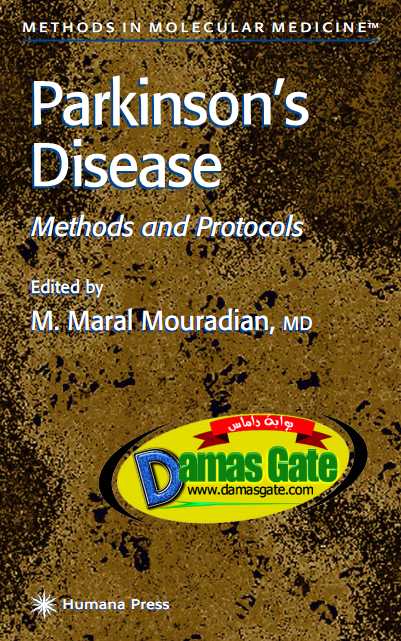Parkinson's Disease: Methods and Protocols (Methods in Molecular Medicine)
M. Maral Mouradian,

Introduction
Idiopathic Parkinson’s disease (PD) is an age-dependent, neurodegenerative
disorder and is predominantly sporadic. Only 20–30% of patients have a positive
family history for PD with a complex mode of inheritance. In a few extended
families, the disease is inherited as an autosomal dominant trait. Linkage
to chromosome 4 was reported in a large Italian kindred multiply affected
by an early-onset form of PD (1). However, this finding was not replicated in a
sample of 94 Caucasian families by Scott et al. (2), or in 13 multigenerational
families by Gasser et al. (3). It has recently been demonstrated that a mutation
within the a-synuclein gene on chromosome 4 segregates with disease in the
Italian family (4). It was further demonstrated that the same missense mutation
was also present in three Greek families with early onset PD. Sequence analysis
of exon 4 of the gene revealed a single base pair change at position 209 from G to
A (G209A). This mutation results in an Ala to Thr substitution at position 53 of
the protein (Ala53Thr) and creates a Tsp45I restriction site (4). This is the first
report of a mutation causing clinically and pathologically defined idiopathic PD
associated with the critical pathologic finding, the intraneuronal inclusions called
Lewy bodies in brainstem nuclei including the substantia nigra. However, Krüger
et al. (5) reported a G→C transversion at position 88 of the coding sequence in
two sibs and the deceased mother in a German family. It was concluded that this
mutation is the cause of PD in this family.
More recently, Papadimitriou et al. (6) reported two additional Greek families
with autosomal dominant PD associated with the G209A mutation in the
α-synucleingene. These families are clinically similar to other PD families
with the mutation in the α-synuclein gene since they also have early onset,
infrequent resting tremor, relatively rapid progression, and excellent response
From: Methods in Molecular Medicine, vol. 62: Parkinson's Disease: Methods and Protocols
Edited by: M. M. Mouradian © Humana Press Inc., Totowa, NJ
Internationally recognized biomedical investigators describe in detail the major techniques employed in molecular and cellular studies of Parkinson's disease and basal ganglia function. Widely varied methods are covered, including genetic analyses, molecular pathogenetic investigations of dopaminergic neuronal degeneration, biochemical studies of nigro-striatal neural circuitry, and molecular therapies, such as gene therapy and neural stem cells.
ISBN: 1617371750 -- edition 2011 -- PDF -- 288 pages -- 1 mb
Download
http://s18.alxa.net/s18/srvs2/02/003....Protocols.rar
M. Maral Mouradian,

Introduction
Idiopathic Parkinson’s disease (PD) is an age-dependent, neurodegenerative
disorder and is predominantly sporadic. Only 20–30% of patients have a positive
family history for PD with a complex mode of inheritance. In a few extended
families, the disease is inherited as an autosomal dominant trait. Linkage
to chromosome 4 was reported in a large Italian kindred multiply affected
by an early-onset form of PD (1). However, this finding was not replicated in a
sample of 94 Caucasian families by Scott et al. (2), or in 13 multigenerational
families by Gasser et al. (3). It has recently been demonstrated that a mutation
within the a-synuclein gene on chromosome 4 segregates with disease in the
Italian family (4). It was further demonstrated that the same missense mutation
was also present in three Greek families with early onset PD. Sequence analysis
of exon 4 of the gene revealed a single base pair change at position 209 from G to
A (G209A). This mutation results in an Ala to Thr substitution at position 53 of
the protein (Ala53Thr) and creates a Tsp45I restriction site (4). This is the first
report of a mutation causing clinically and pathologically defined idiopathic PD
associated with the critical pathologic finding, the intraneuronal inclusions called
Lewy bodies in brainstem nuclei including the substantia nigra. However, Krüger
et al. (5) reported a G→C transversion at position 88 of the coding sequence in
two sibs and the deceased mother in a German family. It was concluded that this
mutation is the cause of PD in this family.
More recently, Papadimitriou et al. (6) reported two additional Greek families
with autosomal dominant PD associated with the G209A mutation in the
α-synucleingene. These families are clinically similar to other PD families
with the mutation in the α-synuclein gene since they also have early onset,
infrequent resting tremor, relatively rapid progression, and excellent response
From: Methods in Molecular Medicine, vol. 62: Parkinson's Disease: Methods and Protocols
Edited by: M. M. Mouradian © Humana Press Inc., Totowa, NJ
Internationally recognized biomedical investigators describe in detail the major techniques employed in molecular and cellular studies of Parkinson's disease and basal ganglia function. Widely varied methods are covered, including genetic analyses, molecular pathogenetic investigations of dopaminergic neuronal degeneration, biochemical studies of nigro-striatal neural circuitry, and molecular therapies, such as gene therapy and neural stem cells.
ISBN: 1617371750 -- edition 2011 -- PDF -- 288 pages -- 1 mb
Download
http://s18.alxa.net/s18/srvs2/02/003....Protocols.rar